Timeline: 15th - 16th century
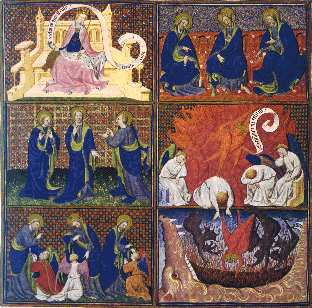
Taken from one of the illuminations of the
Historiated Bible of Guiard des Moulins, believed created around 1410, the bottom far right panel shows a later stylised depiction of the Great Fall, with most of the angels black, and one red. I assume the red one is himself. It’s hardly detailed, but it does get the idea across.
Yeah, even when artists were commissioned, it would seem, to draw their idea (or the Church’s idea, probably - I imagine there were many what would today be called network executives’ notes!) of Hell, few either wanted to or were allowed depict the actual Devil. We have the likes of Bosch’s
Last Judgement, which, while it does feature a sort of Hellish scenario, and a lot of weird and almost alien figures and shapes (this
is Bosch, after all!) looks more to be focused on God overlooking the whole thing, and I can’t see (though maybe I’m wrong) any sign of the actual Devil. Maybe he didn’t get the memo. Bosch does throw him into his famously weird
The Garden of Earthly Delights, but as he portrays him as some sort of devilish bird that eats and then sh
its humans out, I think we’ll just avoid eye contact and be moving along, nothing to see here. Hendrick Goltzius’s sixteenth-century
The Descent into Hell of the Damned features more tits and ass than demons and devils - I mean, there are some vague winged shapes and things that could be demons, but it’s kind of more a sense of macabre titillation I get from it than horror or fear. Again, maybe that’s just me.
A strange image from the fifteenth century shows Satan as almost some sort of early battle beast. He’s hardly human at all - horns, fangs, tusks, pig-like ears, body covered (where it’s not armoured) in some sort of fur or scales, with claws on both hand and foot and a very monstrous-looking face. All that is bad enough, but then he has a second head in a place where, well, let’s just say I wonder how he’s going to take a pee? This second face is kind of like a horned wolf, with a big tongue hanging out - at least, I
hope it’s a tongue! These kind of “hybrid Satans” became somewhat familiar around this period; it was an attempt to further, if you’ll excuse the use of the word, demonise Satan, to dehumanise (or perhaps de-angelify) the Fallen One, show how different he was, not just from God’s angels, but from men. Would
you put your trust in such a monster?
Or in this one, painted by miniature Dutch painters the Limbourg Brothers? I don’t mean they were midgets, but that they painted miniatures, small portraits and things like lockets and so forth. But this was from their work on illustrating a Book of Hours (basically, a devotional prayer book for every hour) called
Belle Heures du Duc de Berry, and shows Satan reposing in Hell, master of his own domain, indulging in his favourite pastime, torturing and eating sinners. For I think the first time though, he wears a crown in this image, denoting his total mastery of Hell. Not that you’d argue with the guy, now would you? The image shown here is back to the bestial, covered in fur, horns, claws, nothing really human about this figure at all.
Looking closer at this image, there’s a lot to take in. Firstly, this Devil is huge. I mean, earlier representations of him were large but this guy is massive. Also, he doesn’t sit on a throne (or in a bowl of soup) but rather on some sort of pallet or stretcher, kind of analogous to those things they used to drag people to the gallows on who were sentenced to be hung, drawn and quartered. Oh wait I see: it’s a huge brazier, on which he’s relaxing, no doubt after a hard day of tempting and sealing deals for the souls of sinners. Well, we all have to kick back every so often. He also seems to be breathing fire (though that could be metaphorical); if so, this is I think the first instance in which he does so. His feet, though not cloven, do have claws (though his hands appear to have normal fingers) and with these, again for the first time in art I think, he grips a human in each, like a massive bird of prey, about to carry them off to his lair.
What’s also intriguing is that, again a first I feel, some of his demons or lieutenants look almost exactly like him. Look at those two guys on the left; other than the crown, they could be brothers to Satan. Then again, there is another primary difference: they have wings (bat wings) whereas Satan does not. Satan also has, - and sorry to keep repeating the phrase, but I don’t know how else to say it - for the first time, the classic high curved horns of a goat, which looks back perhaps to his genesis, when gods like Pan and Bacchus were transformed into the figure we know today as the Devil.
I’m also intrigued by the sinners. If you look closely, you’ll see they all seem to have the same haircut, and it’s the one typified by monks. Are the Limbourg brothers here hinting that even holy men can end up in Hell? Or are they even going further, and accusing the monks of being perhaps not quite as holy as everyone believed and expected them to be. We know that from the fourteenth century on - and possibly before - monks, abbots, nuns and abbesses had broken many of the cardinal rules of the Church, with wives, whores, gluttony, drinking and all sorts of other vices being indulged in behind the walls of the cloisters, those cloisters fantastically and expensively decorated and appointed. Are the Limbourgs pointing out the hypocrisy of men who swore to live simple lives of poverty and chastity, and who broke those vows? Are they saying this will be their reward?
Or is it just coincidence? Are these, perhaps, the only haircuts they could draw, or just the most popular at the time, when maybe everyone was trying to be as pious as they could without actually becoming a monk or a nun? Either way, it’s tempting to think that these brothers are pointing at the Church and saying
you think you’re so cool, but you’ve sinned too: God sees through you, and you’re all bound for Hell too. One last interesting thing about this is that the Limbourgs, though they’ve used a lot of red - mostly in the brazier and in the doomed souls - chose to paint Hell itself not that colour, but a dull grey, maybe to emphasise how miserable a place it is?
This one I really like. Given that it was painted in 1483, I think it looks like some sort of modern cartoon, where the Devil is like a green alien or something! Really funny. And the colours! So bright and vivid. This was part of an altarpiece (which I assume is a set of paintings that adorned an altar in a church) made by German artist Michael Pacher and this pnelt was called
The Devil Presenting St. Augustine with the Book of Vices. Kind of a
This is Your Life, maybe? I’m sure there’s some deep religious significance to such a book, but I’m not really interested in that. I just think it looks cool, and for a fifteenth-century painting, like wow!

Oh all right. Thanks to some clever clogs on Reddit here’s the story: One day St Augustine saw the Devil pass before him carrying a book on his shoulders. He asked the Devil to show him what was inside, and the demon said that there were sins of all men and women that he put down in it. The sneaky bishop looked to see if there was something about his own sins written in there and found the only record of the time when he had forgotten to say
Compline [the Night Prayer]. He ran to a church to briefly complete this prayer. Back with the Devil, Augustine asked him to check that very place in the book with his only sin and, a miracle, it was empty now!
“You have shamefully deceived me, I regret that I showed you my book, because you have cancelled your sin by the power of your prayers!“ - said the Devil and disappeared confounded.
An interesting story, which places the Devil in an odd position, that of bearer and recorder of man’s sins, but more, makes Augustine act in what might be considered a very unsaintly way, essentially cheating his way out of the book, and kind of making us feel a little sympathy for the Devil (sorry) who had been tricked. Usually it’s him that does the tricking. But whatever about the story, the image of the Devil here is pretty unique. Allover green, and looking like a kind of giant anthropomorphic frog or reptile, he has the classic bat wings that were popular in depictions of him around this time (though they. Like the rest of his body, are green not black) and he also has another face in his arse, somewhat like the creature envisaged in the earlier hybrid Satan we saw, as well as a kind of bony ridge running down his back (ending in what looks like the nose of the, if you will, arse face) which is covered with what look like scales. He’s tall and very thin, and his face is kind of lizard-ish, but very alien-looking, though he does sport the goat’s horns on top of his head. His feet, rather than being cloven, are two-toed, but do look almost to end in hooves.
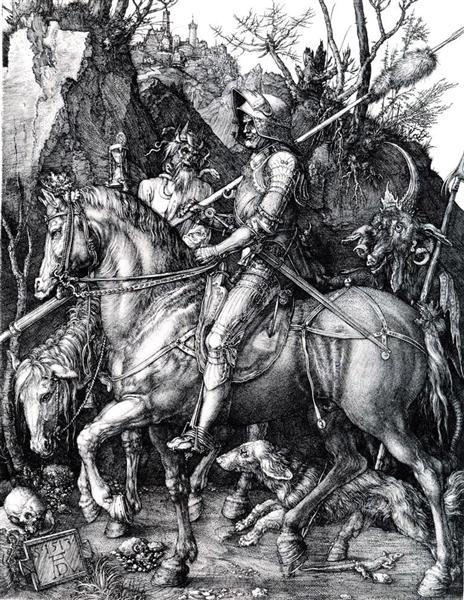
An engraving by Albercht Dürer titled
Knight, Death and the Devil shows our man with those goats legs again but otherwise bearing a pretty striking resemblance both to the blue white-haired and bearded devil of the 13th century painting, and looking not a little like the Greek god Neptune too. Or is that meant to be Death? I think that’s Death, bearing the hourglass. If so, then the guy behind the knight, who looks a little like a badly-drawn Nemesis the Warlock, for those who read
Trollheart’s Futureshock some years ago, and for those who didn’t, he was a character in the
2000 AD strip, said to be a goat, but I don’t quite see it. At any rate, as a representation of the Devil, it’s not great, as the main focus of the engraving is the knight, bravely striding past the two dread figures, but we don’t give a f
uck about him, so as a Devil picture, with all due respect to Dürer, this one sucks.

Satan puts in a guest appearance in the 1546 work showing the
Fall of Man, but the artist, one Guilio Clovio, has gone for the path of least resistance and just painted him as that pesky serpent, whom you can see there wound around the… hey! Stop staring at Eve’s tits! Yes you are! I saw you!
Serpent, son! As Satan would no doubt hiss, “Up here, pal! I’m up
here!”
I find this other one more challenging and interesting, though I can’t seem to find out much about it, other than it may have been painted for a Book of Hours by Carlos Fecha in about 1501. I like the way that the artist has merged the idea of Satan and sin (as represented by Eve) into one figure. Well, two. You have Eve standing looking all innocent on the right (and again, stop looking at her tits!) while wound around the tree on the left is a creature who is a snake up to his head but then takes on the characteristics of a woman, perhaps Eve herself, her head and shoulders (sigh! Yes, and tits) that of a woman, in a perhaps none too subtle depiction of the woman as being the root (sorry) of all evil. Oh, and she has wings too, for some reason.

Even Johannes Saedeler’s 1590 work, rather simply but appropriately titled Hell, while again shows us some sort of cloven-hooved figure dragging a poor doomed soul away, doesn’t really give the idea or impression of a lord of the place bossing everyone around, and that figure could just be a demon. In fact, other than the tortured human souls who take up most of the painting, the eye is mostly drawn to a sort of mixture between a skeleton and a ghost in the bottom right-hand corner, and I have to say that looks decidedly female. A model for Coleridge’s night mare Life-in-Death three hundred years later? The first real sixteenth-century depiction of himself, that I can see anyway, is in Cornelis Galle I’s again appropriately-titled Lucifer, which is almost a study in how the Devil was seen by the mid-sixteenth century.
There he is, with all the by-now traditional marks of the Evil One: hairy goat legs, horns, a beard and for I think the first time - at least, the first I can find - big bat-like wings, deliberately, I would imagine, draw differently to the wings possessed by angels, always shown as white, graceful and swanlike. The Devil’s wings are meant, it would appear, to be a corruption of those worn by God’s messengers, a cold, callous, cruel mockery perhaps of the wings he once possessed as Lucifer, before his Fall. Probably meant to make him look more bestial and less angelic. The addition of wings could possibly be attributed to Florentine writer and poet Dante Alighieri, whose hugely popular
Divine Comedy, and in particular the book dealing with Hell,
Inferno, contains the first mention of Satan in literature. Actually, interestingly the feet are not cloven in this version of the Devil drawn by Galle, but seem to have claws or talons like those of a beast, as do his hands.



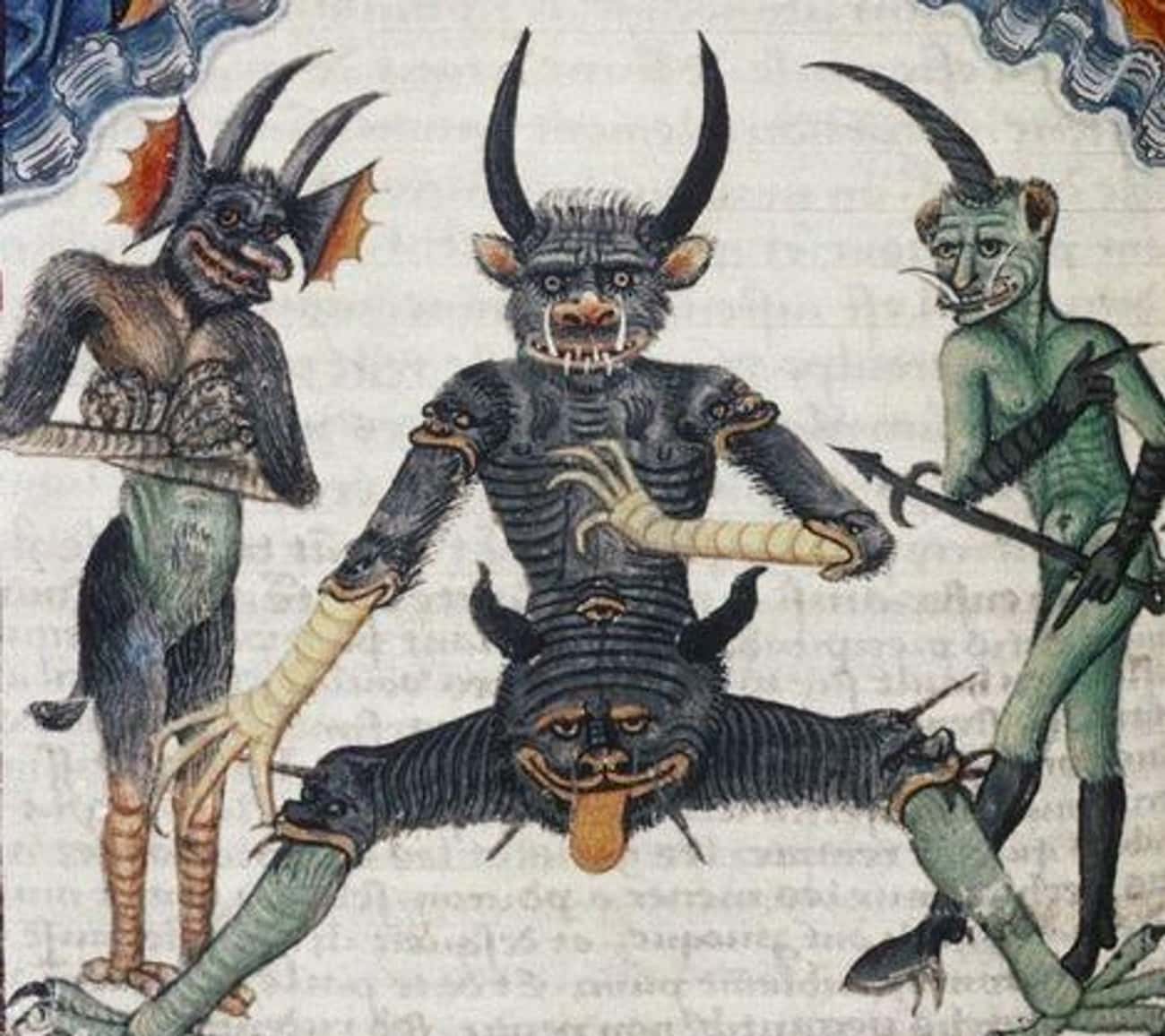
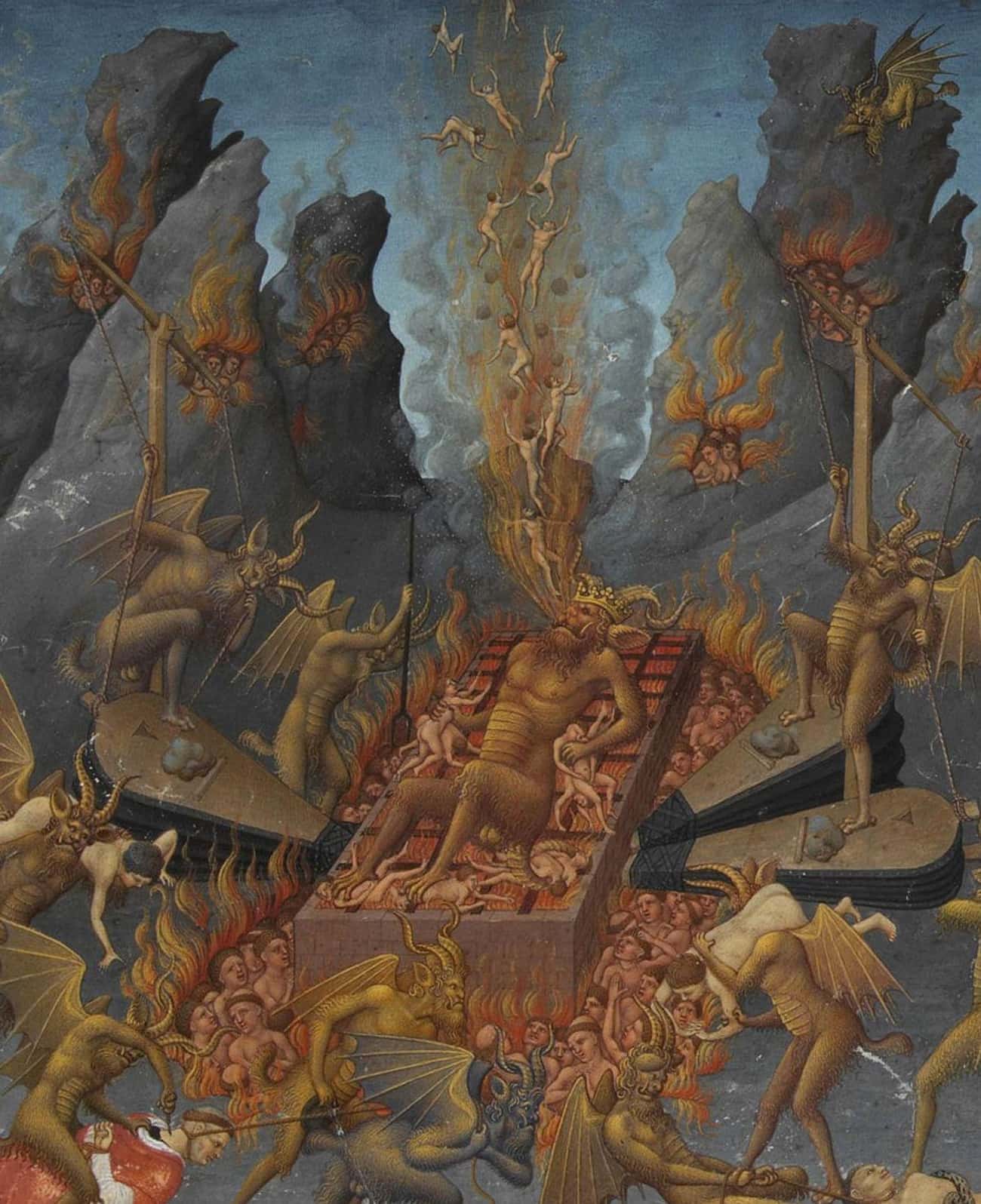











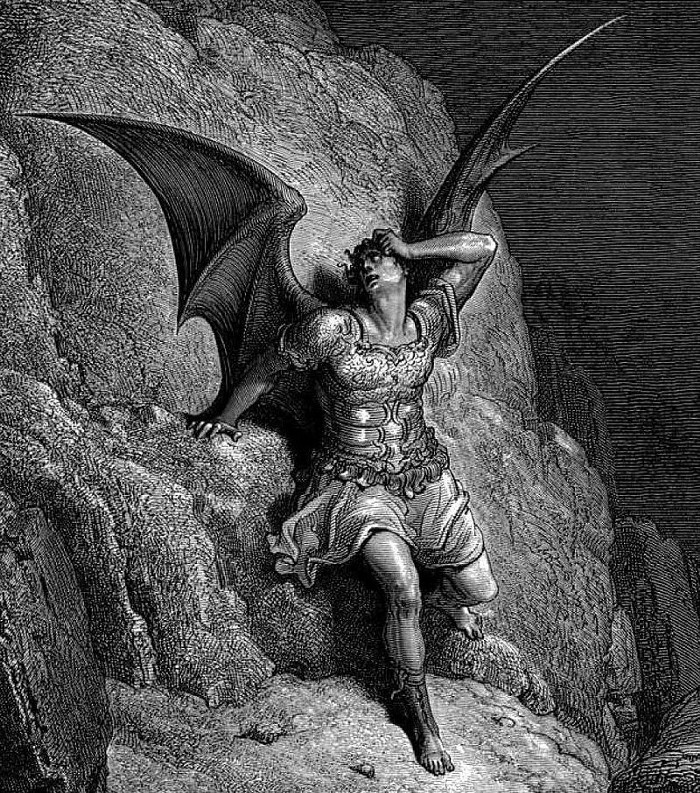

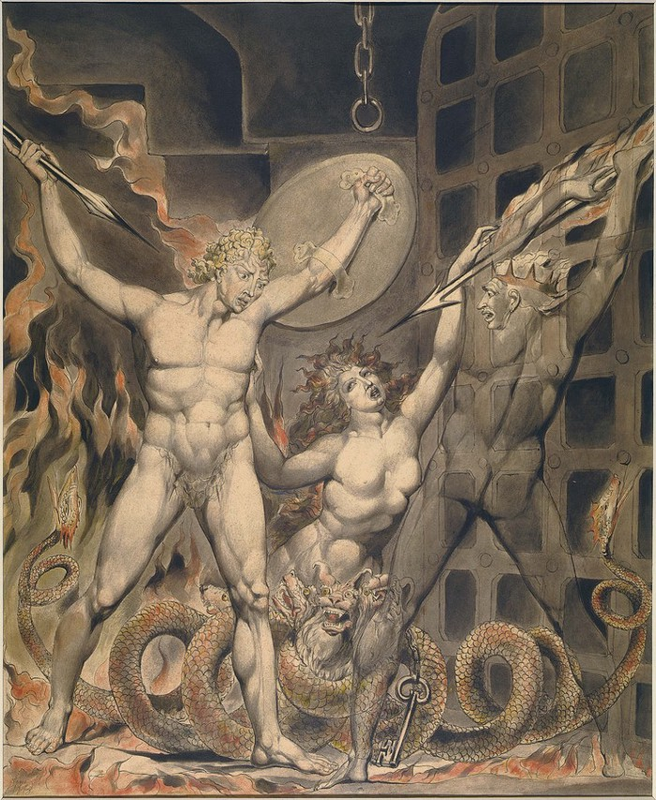
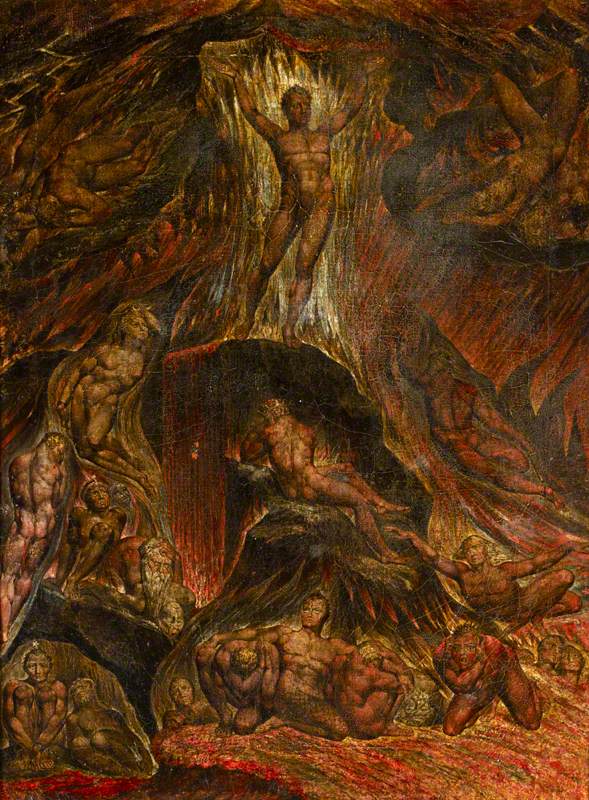


 Hybrid Mode
Hybrid Mode